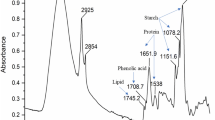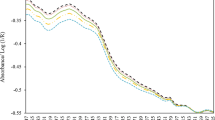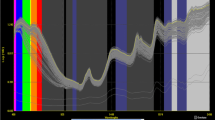Abstract
This study was carried out to determine whether it is possible to detect secondary biochemical components in maize flour samples by near infrared reflectance (NIR) spectroscopy. Two hundred fifty maize samples were used as the material. Calibration models were developed for six different secondary biochemical components, namely amylose, amylopectin, lysine, tryptophan, zein, and phytic acid. The robustness of the calibration models (n = 200) was tested by external validation (n = 50). Results showed that NIR spectroscopy could be used to detect secondary quality components in maize. The most successful prediction model was for amylose content (SEP: 1.784%, RPD: 3.09, r = 0.963). Models for the other traits (amylopectin, zein, lysine, tryptophan, phytic acid) gave acceptable results (RPD > 2) for material screening purposes. Target traits subjected to calibration studies were found to be related to the different overtone regions of C–H, N–H and S–H bond vibrations in scanning the spectral region. It seems that it is necessary to improve the prediction performance of the models using different approaches, such as broadening the spectral area and/or using chemometric technique combinations.



Similar content being viewed by others
References
M. Blanco, I. Villarroya, NIR spectroscopy: a rapid-response analytical tool. Trends Anal. Chem. 21, 240–250 (2002)
H. Cen, Y. He, Y, Theory and application of near infrared reflectance spectroscopy in determination of food quality. Trends Food Sci. Technol. 18, 72–83 (2007)
P. Sudhakar, P. Latha, P.V. Reddy, Kernel quality traits, in Phenotyping Crop Plants for Physiological and Biochemical Traits, ed. by P. Sudhakar, P. Latha, P.V. Reddy (Academic Press, Cambridge, 2016), pp. 87–94
P.L. Pingali, Green revolution: impacts, limits, and the path ahead. Proc. Natl. Acad. Sci. U.S.A. 109, 12302–12308 (2012)
C.Ö. Egesel, F. Kahriman, Determination of quality parameters in maize grain by NIR reflectance spectroscopy. J. Agric. Sci. 12, 31–42 (2012)
B.A. Orman, R.A. Schumann, Comparison of near-infrared spectroscopy calibration methods for the prediction of protein, oil, and starch in maize grain. J. Agric. Food Chem. 39, 883–886 (1991)
Y. Zhang, L.-D. Zhang, Q.-L. Bai, S.-J. Chen, Nondestructive identification of different oil content maize kernels by near-infrared spectra. Guang Pu 29, 686–689 (2009)
O.V. Brenna, N. Berardo, Application of near-infrared reflectance spectroscopy (NIRS) to the evaluation of carotenoids content in maize. J. Agric. Food Chem. 52, 5577–5582 (2004)
A. Rosales, L. Galicia, E. Oviedo, C. Islas, N. Palacios-Rojas, Near-infrared reflectance spectroscopy (NIRS) for protein, tryptophan, and lysine evaluation in quality protein maize (QPM) breeding programs. J. Agric. Food Chem. 59, 10781–10786 (2011)
T.M. Baye, T.C. Pearson, A.M. Settles, Development of a calibration to predict maize seed composition using single kernel near infrared spectroscopy. J. Cereal Sci. 43, 236–243 (2006)
C.Ö. Egesel, F. Kahriman, N. Ekinci, I. Kavdir, M.B. Büyükcan, Analysis of fatty acids in kernel, flour, and oil samples of maize by NIR Spectroscopy using conventional regression methods. Cereal Chem. 93, 487–492 (2016)
F. Kahrıman, İ. Onaç, F. Mert, F. Öner, C.Ö. Egesel, Determination of carotenoid and tocopherol content in maize flour and oil samples using near-infrared spectroscopy. Spectrosc. Lett. 52, 473–481 (2019)
A.A. Mangalvedhe, M.C. Danao, M. Paulsmeyer, K.D. Rausch, V. Singh, J.A. Juvik, Anthocyanin determination in different corn hybrids using near infrared spectroscopy Written for presentation at the 2015 ASABE Annual International Meeting Sponsored by ASABE New Orleans. Louisiana 7004, 3–14 (2015)
Megazyme, Amylose/Amylopectin Assay Procedure K-amyl 09/14 for the Measurement of the Amylose and Amylopectin Contents of Starch, Megazyme Internatrional Ireland (2014)
J.C. Yau, A.J. Bockholt, J.D. Smith, L.W. Rooney, R.D. De Waniska, Maize endosperm proteins that contribute to endosperm lysine content. Cereal Chem. 76, 668–672 (1999)
L. Galicia, E. Nurit, A. Rosales, N. Palacios-Rojas, Maize nutrition quality and plant tissue analysis laboratory, Laboratory Protocols (2008)
K. Dost, O. Tokul, Determination of phytic acid in wheat and wheat products by reverse phase high performance liquid chromatography. Anal. Chim. Acta 558, 22–27 (2006)
CWS Manual, Sensologic Calibration Workshop Version 2.02 (Sensologic Gmbh, Norderstedt, 2003)
CAMO Software AS, The Unscrambler Appendices: Method References, PDF from CAMO website, https://www.camo.com/helpdocs/The_Unscrambler_Method_References.pdf, CAMO Software AS (2019)
J. Fontaine, B. Schirmer, J. Horr, Near-infrared reflectance spectroscopy (NIRS) enables the fast and accurate prediction of essential amino acid contents. 2. Results for wheat, barley, corn, triticale, wheat bran/middlings, rice bran, and sorghum. J. Agric. Food Chem. 2002(50), 3902–3911 (2002)
M.R. Campbell, S.R. Mannis, H.A. Port, A.M. Zimmerman, D.V. Glover, Prediction of starch amylose content versus total grain amylose content in corn by near-infrared transmittance spectroscopy. Cereal Chem. 76, 552–557 (1999)
P.N. Chiangmai, P. Yodmingkhwan, P. Nilprapruck, C. Aekatasanawan, M. Kanjanamaneesathian, Screening of phytic acid and inorganic phosphorus contents in corn inbred lines and F1 hybrids in tropical environment. Maydica 56, 331–339 (2011)
U. Konietzny, R. Greiner, Phytic Acid: Nutritional Impact. Encyclopedia of Food Sciences and Nutrition, 2nd edn. (Elsevier, London, 2003), pp. 4555–4563
B. Cong, C. Maxwell, S. Luck, D. Vespestad, K. Richard, J. Mickelson, C. Zhong, Genotypic and environmental impact on natural variation of nutrient composition in 50 non-genetically modified commercial maize hybrids in North America. J. Agric. Food Chem. 63(22), 5321–5533 (2015)
M. Tang, X. He, Y. Luo, L. Ma, X. Tang, K. Huang, Nutritional assessment of transgenic lysine-rich maize compared with conventional quality protein maize. J. Sci. Food Agric. 93, 1049–1054 (2013)
A.C. Newton, T. Akar, J.P. Baresel, P.J. Bebeli, E. Bettencourt, K.V. Bladenopoulos, J.H. Czembor, D.A. Fasoula, A. Katsiotis, K. Koutis, M. Koutsika-Sotiriou, G. Kovacs, H. Larsson, M.A.A.P. de Carvalho, D. Rubiales, J. Russell, T.M.M. Dos Santos, M.C. Vaz Patto, Cereal landraces for sustainable agriculture. A review. Agron. Sustain. Dev. 30, 237–269 (2010)
C.W. Chang, D.A. Laird, M.J. Mausbach, C.R. Hurburgh, Near-infrared reflectance spectroscopy - Principal components regression analyses of soil properties. Soil Sci. Soc. Am. J. 65, 480–490 (2001)
A.A. Vicente, M.A. Cerqueira, L. Hilliou, C.M.R. Rocha, Protein-based resins for food packaging, in Multifunctional and Nanoreinforced Polymers for Food Packaging, ed. by J.-M. Lagarón (Woodhead Publishing, Cambridge, 2011), pp. 610–648
X. Fan, S. Tang, G. Li, X. Zhou, Non-invasive detection of protein content in several types of plant feed materials using a hybrid near infrared spectroscopy model. PLoS ONE 11(9), e0163145 (2016)
B. H. Holder, Characterization of starch by vibrational spectroscopy [Dissertations & Theses in Food Science and Technology], University of Nebraska-Lincoln, Lincoln, Neb, USA (2012)
T. Iwai, M. Takahashi, K. Oda, Y. Terada, K.T. Yoshida, Dynamic changes in the distribution of minerals in relation to phytic acid accumulation during rice seed development. Plant Physiol. 160, 2007–2014 (2012)
R. Zhao, X. Xu, J. Li, C. Li, J. Chen, Y. Liu, S. Zhu, Rapid determination of phytic acid content in cottonseed meal via near infrared spectroscopy. J. Near Infrared Spectrosc. 25, 188–195 (2017)
C.C. Fertig, F. Podczeck, R.D. Jee, M.R. Smith, Feasibility study for the rapid determination of the amylose content in starch by near-infrared spectroscopy. Eur. J. Pharm. Sci. 21(2–3), 155–159 (2004)
P.S. Sampaioa, A. Soares, A. Castanho, A.S. Almeida, J. Oliveira, C. Brites, Optimization of rice amylose determination by NIR-spectroscopy using PLS chemometrics, algorithms. Food Chem. 242, 196–204 (2018)
J.Y. Chen, Y. Miao, S. Sato, H. Zhang, Near infrared spectroscopy for determination of the protein composition of rice flour. Food Sci. Technol. Res. 14(2), 132–138 (2008)
F. Kahriman, C.Ö. Egesel, Development of a calibration model to estimate quality traits in wheat flour using NIR (near infrared reflectance) spectroscopy. J. Agric. Sci. 43, 392–400 (2011)
D.F. Barbin, A.L.S.M. Felicio, D.-W. Sun, S.L. Nixdorf, E.Y. Hirooka, Application of infrared spectral techniques on quality and compositional attributes of coffee: an overview. Food Res. Int. 61, 23–32 (2014)
Y. Ozaki, Near-infrared spectroscopy—its versatility in analytical chemistry. Anal. Sci. 28, 545–563 (2012)
F. Kahrıman, F. Öner, F.M. Turk, A. Gökçe, E. Düzen, İ. Onaç, C.Ö. Egesel, Efficiency of different chemometric methods for determination of oil content in maize by NIR spectroscopy. VIII International Scientific Agriculture Symposium, "Agrosym 2017", Jahorina, Bosnia and Herzegovina, October 2017. Book of Proceedings, pp.788–793 (2017)
Acknowledgements
The authors acknowledge the financial support of the Scientific and Technological Research Council of Turkey (TUBITAK, Project ID: 215O867).
Author information
Authors and Affiliations
Corresponding author
Additional information
Publisher's Note
Springer Nature remains neutral with regard to jurisdictional claims in published maps and institutional affiliations.
Rights and permissions
About this article
Cite this article
Kahrıman, F., Onaç, İ., Öner, F. et al. Analysis of secondary biochemical components in maize flour samples by NIR (near infrared reflectance) spectroscopy. Food Measure 14, 2320–2332 (2020). https://doi.org/10.1007/s11694-020-00479-0
Received:
Accepted:
Published:
Issue Date:
DOI: https://doi.org/10.1007/s11694-020-00479-0




